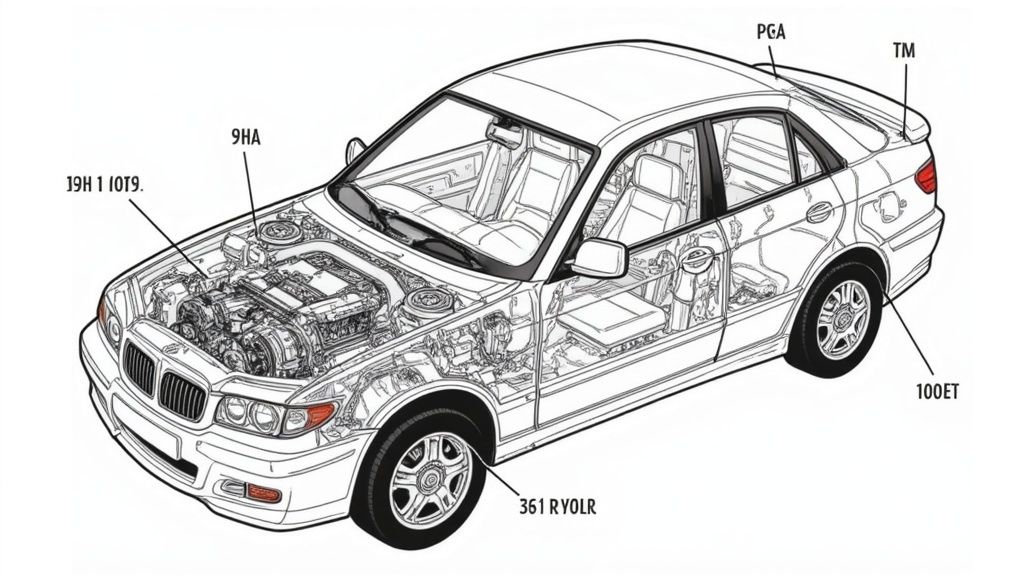
Ultimate Guide to Auto Maintenance Tracking: Boost Your Car's Health
Understanding Modern Vehicle Maintenance Challenges

Managing vehicle maintenance has become increasingly complex for car owners. Basic oil changes are just the start - modern vehicles need multiple services performed at specific intervals, from tire rotations to brake inspections, fluid changes, and filter replacements. For busy car owners, keeping track of all these maintenance needs while juggling other responsibilities can feel like an overwhelming task.
The Hidden Costs of Neglect
Poor maintenance habits come with serious consequences that many owners don’t anticipate. According to CARFAX, 29% of car owners are behind on oil changes, while 44% haven’t rotated their tires on schedule. These missed service intervals lead to real costs - cars run less efficiently when components and fluids are worn, resulting in higher fuel consumption. As a result, owners end up spending more money at the gas pump simply because they delayed basic maintenance.
The risks go beyond just poor fuel economy. Skipping recommended service greatly increases the chances of mechanical failures that could leave you stranded. Emergency roadside repairs and towing fees quickly add up to major unexpected expenses that could have been prevented through regular maintenance tracking. By staying on top of service schedules, owners can spot potential issues early before they become expensive emergencies.
Regional Differences in Vehicle Care
Maintenance habits show interesting geographic patterns across the United States. CARFAX data reveals that states like Alaska, West Virginia, and Maine have more “Service Slackers” who frequently miss maintenance deadlines. In contrast, Wisconsin, Minnesota, and Utah have more “Maintenance Mavens” who prioritize regular service. These differences often reflect local factors - harsh winter climates may require more frequent fluid changes, while rural driving conditions can accelerate tire wear. Understanding these regional needs helps owners develop appropriate maintenance schedules.
Strategies for Successful Auto Maintenance Tracking
Many vehicle owners have developed effective systems for managing maintenance needs. Some use digital service tracking apps, while others rely on calendar reminders and detailed service records. The most successful owners build relationships with trusted mechanics who provide reliable guidance. They understand that consistent maintenance tracking leads to long-term savings and vehicle reliability. By following organized maintenance practices and working with qualified service providers, owners can reduce risks and costs while gaining peace of mind about their vehicle’s condition.
Building Your Financial Case for Maintenance Tracking

Keeping detailed records of your auto maintenance does more than just help you stay on top of repairs - it’s a smart financial strategy that can save you significant money over time. By tracking maintenance consistently, you can avoid expensive repairs, maximize your car’s resale value, and make smarter spending decisions. Let’s explore exactly how proper maintenance tracking translates into real financial benefits.
The Impact of Auto Maintenance Tracking on Resale Value
When it comes time to sell your vehicle, having complete maintenance records can directly increase its value. Buyers are naturally more confident purchasing a car with documented service history that shows regular oil changes, tire rotations, and other routine maintenance. This documented care gives them peace of mind that the vehicle has been properly maintained. Studies show that well-maintained vehicles with complete records can command around $330 more at resale compared to similar vehicles without service documentation. Think of maintenance records as proof that validates your car’s condition and value.
Avoiding Costly Repairs Through Preventative Maintenance
Regular maintenance tracking helps you catch small issues before they become major problems. Just like going to regular dental checkups prevents the need for root canals, staying ahead of car maintenance prevents expensive emergency repairs. According to a recent FinanceBuzz survey, 46% of drivers ended up paying for repairs they believe proper maintenance could have prevented. By following recommended service schedules and addressing minor problems early, you can avoid being stranded with a broken-down car and facing steep repair bills.
Budgeting and Emergency Funds for Vehicle Maintenance
Tracking maintenance makes it much easier to plan your car care expenses. When you know exactly when services are due, you can budget for them in advance rather than being surprised by large repair bills. Setting aside money each month for both routine maintenance and unexpected repairs provides peace of mind. Having this dedicated maintenance fund ensures you can properly care for your vehicle without financial stress.
Prioritizing Cost-Effective Preventative Maintenance
Not all maintenance tasks carry equal importance or urgency. Good maintenance tracking helps you identify which services deliver the most value for your money. Simple services like regular oil changes and tire rotations are relatively inexpensive but crucial for preventing major engine and tire problems down the road. By focusing first on these high-impact maintenance items, you can protect your car while spending wisely. This strategic approach ensures you’re investing in the right services at the right time to keep your vehicle reliable and valuable for years to come.
Overcoming Common Maintenance Roadblocks

While most car owners understand the value of regular vehicle maintenance, putting it into practice often presents real challenges. From busy schedules to budget constraints, several common roadblocks can make consistent maintenance tracking feel like an uphill battle. However, with practical strategies and the right tools, these obstacles become much more manageable.
Time Constraints and Busy Schedules
Finding time for car maintenance amid work, family, and other commitments is a constant challenge for many car owners. The key is treating maintenance appointments like any other essential commitment and planning ahead. For instance, setting a phone reminder one week before your next oil change gives you time to adjust your schedule and book the appointment. Making maintenance a regular part of your calendar, rather than an afterthought, helps ensure it doesn’t get pushed aside when life gets busy.
Budget Limitations and Unexpected Expenses
The cost of car maintenance can feel daunting, especially when unexpected repairs arise. However, regular preventative care typically costs far less than major repairs caused by neglect. By tracking maintenance needs and planning ahead, car owners can budget appropriately and avoid financial strain. Many service providers also offer payment plans or maintenance packages that make costs more predictable and manageable over time.
Finding Trustworthy and Reliable Service Providers
Many car owners delay maintenance because they’re unsure where to find honest, reliable service. The best approach is to research thoroughly and ask for recommendations from friends, family and local car enthusiast groups. Once you find a trustworthy mechanic, maintaining open communication about service needs and costs becomes much easier. This relationship built on trust makes ongoing maintenance feel less intimidating.
Streamlining the Process With Auto Maintenance Tracking Software
Using dedicated maintenance tracking tools like Auto Service Logger can simplify the entire process of managing vehicle care. These applications let owners digitally store service records, set automated maintenance reminders, and monitor car-related expenses in one place. With comprehensive maintenance history at their fingertips, car owners can stay organized, anticipate needs, and maintain their vehicles proactively rather than reactively.
Modern Tracking Tools and Technologies

Keeping up with auto maintenance requires more than just remembering when to change your oil - it demands an organized system to track service needs and protect your vehicle investment. Thanks to advances in technology, there are now many practical tools that can help vehicle owners stay on top of maintenance schedules. Whether you prefer simple tracking methods or want detailed analytics, you can find an approach that fits your style and budget.
Auto Maintenance Tracking Options
Gone are the days when a paper logbook was the only way to track vehicle maintenance. Today’s options range from basic digital tools to full-featured management systems. Free spreadsheet templates offer a straightforward way to log service dates and mileage. Mobile apps make tracking portable and often include helpful service reminders. Programs like Auto Service Logger provide complete maintenance record keeping with expense tracking and detailed reporting capabilities.
For those wanting deeper insights, vehicle telematics systems collect real-time data on engine performance, fuel usage, and other metrics. This detailed information helps catch potential problems early and optimize service timing. While telematics systems cost more upfront, their comprehensive monitoring capabilities make them valuable for commercial fleets or owners who want thorough vehicle oversight.
Selecting Your Ideal Tracking Solution
Finding the right maintenance tracking tool depends on your specific needs and preferences. If you like to keep things simple, a basic spreadsheet or mobile app may be perfect. For managing multiple vehicles or complex maintenance schedules, dedicated software or telematics could be worth the investment. For instance, a family with two cars might benefit most from a shared app that coordinates maintenance timing. Small business owners running vehicle fleets often find that telematics systems pay for themselves through better maintenance planning and cost control.
Cost is another key factor to consider. While spreadsheets and basic apps are often free, premium features like automated reminders, cloud storage, and detailed analytics usually require a subscription. Take time to evaluate which capabilities matter most to you and choose a solution that delivers good value for your situation.
Making Maintenance Tracking a Habit
The most important aspect of any tracking system is using it consistently. Build maintenance tracking into your regular routine by recording details right after each service - note the date, mileage, and type of work done. Take photos of receipts and paperwork to maintain complete records. Set up reminders for upcoming services so nothing gets overlooked. With regular updates and reviews of your maintenance history, tracking becomes a natural part of vehicle care rather than a burdensome task. This consistent approach helps maximize your vehicle’s reliability and resale value while preventing costly repair surprises.
Designing Your Custom Maintenance Strategy
Every vehicle needs a maintenance plan that fits its specific requirements and usage patterns. While manufacturer guidelines provide a good starting point, creating a personalized maintenance strategy helps extend your vehicle’s life while keeping costs under control. By understanding your vehicle’s needs, driving patterns, and maintenance tools, you can build an effective plan that works for your situation.
Assessing Your Vehicle’s Unique Needs
Each vehicle type has specific maintenance demands. For instance, a pickup truck used for heavy towing needs more frequent brake inspections and fluid changes compared to a sedan used for city commuting. Start by checking your owner’s manual for the basic maintenance schedule - this forms the foundation for your custom plan. Consider factors like your vehicle’s age, total mileage, and operating environment. Weather conditions like extreme temperatures affect how often certain maintenance tasks need to be done.
Analyzing Your Driving Habits
Your driving style has a direct impact on maintenance needs. City driving with frequent stops puts more strain on brakes and engine components compared to steady highway cruising. If you often drive on rough roads or make many short trips, you’ll likely need more frequent oil changes than the standard intervals. For example, cold starts during short trips prevent the engine from fully warming up, leading to increased wear. Understanding these patterns helps you adjust service timing to match real-world use.
Creating a Personalized Maintenance Schedule
With a clear picture of your vehicle’s requirements and driving patterns, you can create a tailored maintenance plan. Use a spreadsheet or maintenance app like Auto Service Logger to track service items. List each maintenance task along with recommended intervals, last service date, and mileage. Then modify these timeframes based on your specific conditions and usage. Regular tracking helps catch potential issues early before they become major problems.
Setting Reminders and Staying Organized
Good organization is key for following through with maintenance plans. Set up reminders through your chosen tracking system for upcoming services based on mileage or time intervals. Include monthly checks of basics like tire pressure, fluid levels, and visual inspections. For example, scheduling a quick tire inspection on the first of each month can help catch slow leaks or uneven wear patterns. These simple reminders keep you focused on preventive maintenance.
Adapting Your Plan Over Time
As vehicles age, their maintenance needs change. A car with 100,000 miles often requires more frequent checks of wear items like belts, hoses and suspension components compared to when it was new. Review your maintenance records regularly to spot any developing patterns or recurring issues. Update service intervals based on your vehicle’s actual condition and performance. Being flexible with your maintenance strategy ensures your vehicle gets appropriate care throughout its life.
Measuring Success and Long-Term Impact
Every investment in auto maintenance tracking should deliver clear results. To understand if your tracking system is truly effective, you need concrete ways to measure its impact over time. This goes beyond simply following a maintenance schedule - it’s about seeing how your diligent record-keeping translates into real benefits for both your vehicle and your finances.
Quantifying the Returns of Auto Maintenance Tracking
The clearest indicator of success is the money you save through preventive maintenance. Small, regular investments in maintenance can help you avoid major repair bills down the road. This isn’t just theory - according to a FinanceBuzz survey, 46% of drivers have paid for repairs that proper maintenance could have prevented. Those statistics show the real financial benefits of staying on top of your vehicle’s care.
Your vehicle’s resale value also directly reflects your maintenance efforts. When you maintain detailed service records, potential buyers can see proof of consistent care. This documentation builds confidence and often leads to higher selling prices. Research shows that vehicles with complete maintenance histories frequently sell for hundreds more than similar vehicles without records. That premium represents a measurable return on your investment in maintenance tracking.
Key Performance Indicators (KPIs) for Maintenance Success
To effectively evaluate your maintenance tracking, focus on these specific measurable indicators:
- Reduced Repair Costs: Monitor your yearly repair expenses. Declining costs over time show your preventive maintenance is working.
- Improved Fuel Efficiency: Regular maintenance like tune-ups and filter changes should boost your gas mileage. Track your MPG to see the results.
- Decreased Downtime: Count the days your vehicle is unusable due to repairs. Fewer breakdown days means your maintenance plan is succeeding.
- Increased Resale Value: When selling, compare your price to similar vehicles without maintenance records. The difference shows the value of your careful tracking.
| KPI | Target | Measurement Method |
|---|---|---|
| Reduced Repair Costs | Year-over-year decrease | Compare annual repair expenses |
| Improved Fuel Efficiency | Increased miles per gallon (MPG) | Track fuel consumption and mileage |
| Decreased Downtime | Fewer days out of commission due to breakdowns | Log dates and reasons for vehicle unavailability |
| Increased Resale Value | Higher selling price compared to similar cars | Compare selling price to market value estimates |
Adapting Your Strategy for Optimal Results
Your maintenance tracking needs to evolve as your vehicle ages and your driving patterns change. Review your records and performance indicators regularly. Are you seeing continued improvements? Do certain issues keep coming up? For example, if you notice frequent brake work, investigate why and adjust your maintenance schedule accordingly.
By analyzing your data and refining your approach, you can make your tracking system more effective over time. This helps preserve your vehicle’s condition while making the most of your maintenance budget.
Ready to take control of your vehicle maintenance and see real, lasting benefits? Auto Service Logger provides all the tools you need to track maintenance, set reminders, and protect your vehicle’s value. Start building your maintenance tracking system today.